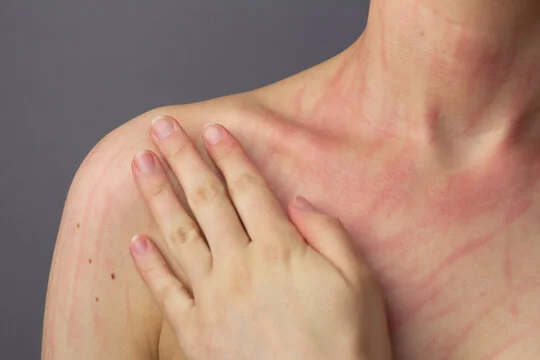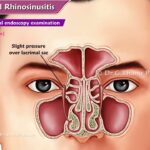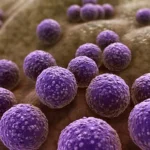What is Dermatographic Urticaria?
Dermatographic urticaria, also known as dermographism or “skin writing,” is a common skin condition characterized by raised, red, itchy welts that appear in response to minor scratches or pressure on the skin. These welts typically develop within minutes and may persist for several hours before fading without treatment.

Causes and Triggers of Dermatographic Urticaria
The exact cause of dermatographic urticaria remains unclear, but it is believed to result from an exaggerated histamine response triggered by physical stimuli. Common triggers include:
- Mechanical pressure (scratching, rubbing, tight clothing)
- Temperature changes (hot showers, cold exposure)
- Stress and anxiety
- Infections (viral or bacterial)
- Certain medications (antibiotics, NSAIDs)
- Allergens and irritants (soaps, chemicals, fragrances)
Symptoms of Dermatographic Urticaria
The hallmark symptoms of dermatographic urticaria include:
- Raised, red, or skin-colored welts following minor skin trauma
- Itching or burning sensation
- Rapid onset of symptoms within 5–10 minutes
- Welts that fade within 30 minutes to a few hours
- No residual scarring or bruising
Diagnosis and Medical Evaluation
A dermatologist or allergist can diagnose dermatographic urticaria based on a physical examination and patient history. The “skin writing test” is commonly used: a blunt object is drawn across the skin to observe if raised welts appear within minutes.
Differential Diagnosis
Dermatographic urticaria must be distinguished from:
- Chronic urticaria (hives lasting longer than six weeks)
- Mastocytosis (excess mast cells leading to hives and anaphylaxis)
- Contact dermatitis (skin reaction to allergens or irritants)
Treatment and Management Strategies
While dermatographic urticaria is generally harmless, its symptoms can be bothersome. Treatment focuses on relieving itching and preventing flare-ups.
Medications
- Antihistamines (cetirizine, loratadine, fexofenadine) reduce histamine response.
- Topical corticosteroids (for severe itching, though rarely needed).
- Leukotriene receptor antagonists (montelukast) in resistant cases.
Lifestyle and Home Remedies
- Avoid scratching to prevent worsening symptoms.
- Wear loose-fitting clothing to minimize friction.
- Use fragrance-free skincare products to prevent irritation.
- Maintain skin hydration with hypoallergenic moisturizers.
- Manage stress through relaxation techniques such as yoga or meditation.
Natural Remedies
Some individuals find relief using:
- Aloe vera gel to soothe irritation.
- Oatmeal baths to reduce itching.
- Cold compresses to minimize inflammation.
Preventing Flare-Ups
Preventive measures involve avoiding known triggers and adopting a gentle skincare routine. Consider:
- Identifying personal triggers through trial and observation.
- Keeping nails short to reduce skin trauma.
- Using mild detergents and avoiding harsh soaps.
Prognosis and Long-Term Outlook
Dermatographic urticaria is often a chronic condition but can improve over time. Some individuals experience spontaneous remission, while others require long-term management with antihistamines and trigger avoidance.

